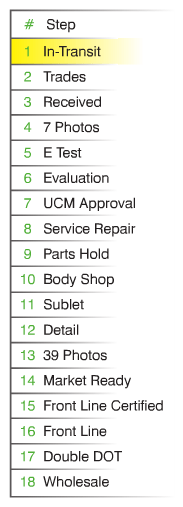16 Feb Time-to-Market: Reconditioning at DePaula Chevrolet

Several years ago, I attended a 20 Group meeting hosted by Rydell Chevrolet in Grand Forks, North Dakota. At that meeting, Dale Pollak had been a guest speaker and, on the flight out, I had the chance opportunity to be seated next to him.
We talked about the state of the used car business, which eventfully led to a discussion of how to convince dealers to change processes for better results. One point I well remember is Dale’s comment about where best to spend our time when getting our new business of the ground. He said, “In my experience, it is always the best dealers who want to get even better, so work with dealers who are already performing well.”
When our company was started, Dale’s sound advice was foremost in our minds when it came time to focus in on our energy and resources. Our initial customers and early adopters were from well-performing dealerships with strong management teams. They were just plain tired of not knowing what was going on in their reconditioning departments. They knew things were not working, and were not afraid to try something totally new in order to fix their problems. The first few systems we put in place were basic, with only five or six steps to track cars from Received to the Front Line — basically, keeping better track of what was already being done.
Our primary objective was measuring actual recon cycle time at each step. Once the data was captured for two to three months in each dealership, average days in recon were universally two to three times longer than what they had previously assumed about their own numbers. The range was between a low of 8.5 days to as high as 18 days. By the end of our pilot year, we had collected data on 50,000 cars and I was convinced that a best-case scenario for any dealer to sustain was in the range of five or six days, taking into account any problem cars along with the clean ones.
However, by mid-2012, the recon workflow software had evolved to the point where it was highly automated. It keeps all necessary dealership and recon personnel (including significant outside vendors) informed as to what they own, and displays each car and person at every step from start to finish in real time. It also enables management to quickly make changes in priorities and minimize any bottlenecks. By this time, we were seeing significant reductions in the averages, and it seemed that three to five days was an attainable target. Then along came DePaula Chevrolet in Albany, New York.
When I first talked to Tom Restino, vice president of operations, and Paul Lynch, general sales manager, they explained that they needed to recondition 150 to 200 cars each month and were committed to a 24-hour turn from Received to the Front Line. At first, I thought he was just setting the bar too high, but after three months of measuring and monitoring his real-time workflow process, they are, in fact, meeting the 24-hour objective. Their process consists of the 18 Steps and their “time to market” metric (see below) starts with “Purchases or Cleared Trades” and ends at “Market Ready.” It is also notable that DePaula ranks in vAuto’s “Top-20 Dealers,” so Dale’s insight about the best getting better certainly applies.
To be clear, achieving and maintaining a 24-hour recon cycle time means you have to structure your processes such that it works more like a pit crew. The results, however, are that everything works better — sales are accelerated and the bottom line is what dealers dream about. In the specific case of DePaula, they do try to buy clean cars to complement the clean trades. They have dedicated techs and detail teams. Seven photos are taken and uploaded when the car is received, followed immediately by the service evaluation and the UCM’s decision regarding which repairs he is willing to approve. All this takes one or two hours, and is all linked with text messages so no actual meetings or discussions are needed. This allows the UCM to multitask and the service repairs to be done without delay. If parts are not on the shelf, the parts manager has the hot potato. To get to this level, you have to commit your recon process and resources to this end. Also, making sure the recon manager is financially rewarded is an essential part of their success.
Uploading photos has typically been the final step in the reconditioning process, but all that appears to be changing. The Internet has driven dealers to photograph and upload each car in the beginning steps to maximize the number of selling days. DePaula takes seven photos when the cars come off the transport or the trades are cleared (as shown here in Step 4) to get a jump start online, followed by a full set of 39 photos 24 hours later.
If there is inconsistency and lack of accountability in your recon numbers, perhaps it is time to ask how much time and money is your dealership leaving on the table. There is an easy solution which takes little time to get your dealership up and running that gives clear insight into your entire recon process. I can help you calculate a number, or you can do it yourself by adding another used car turn per year just as a starting point. And then, it just gets better from there.
Dennis McGinn is the founder and CEO of Rapid Recon. He can be contacted at 866.268.3582, or by e-mail at dmcginn@autosuccessonline.com


Sorry, the comment form is closed at this time.